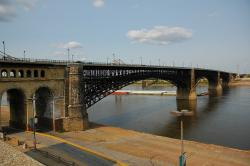
In the decade following the Civil War, the Mississippi River began to lose its standing as the primary transport artery in the Midwest. Railroads were taking over, and Chicago was rapidly becoming the center of Midwestern commerce. The Eads Bridge was the first major railroad link over the Mississippi, constructed by the city of St. Louis in an attempt to maintain its dominance as a regional commercial hub.
The bridge's designer and builder, James Buchanan Eads, faced unbelievable challenges: political and financial wrangles; shipwrecks, ice storms, and tornadoes; and 14 men dead from caisson disease. Seven years and 7 million dollars after construction began, the bridge opened, carrying fifteen 50-ton locomotives loaded with coal, water, and daredevil passengers. The bridge continues to carry traffic across the Mississippi River today.
Resources
- Howard S. Miller and Quinta Scott, The Eads Bridge, University of Missouri Press, 2nd Ed.1999



